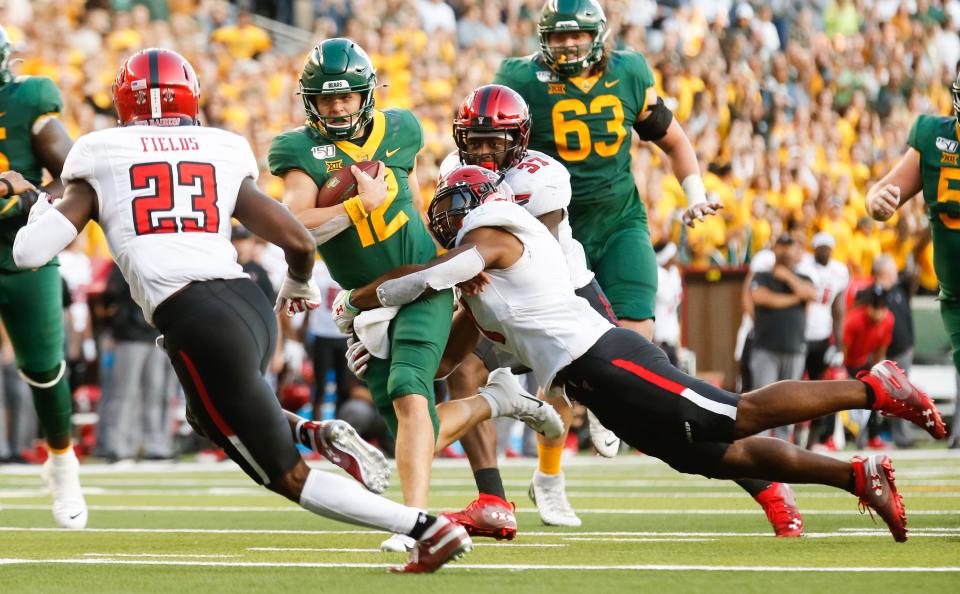Could relegation work in today's college football landscape?

I enjoy soccer, but I’m not a true fan.
Though I love playing FIFA video games, watching the World Cup every four years and occasionally playing pick-up soccer games at a local park, I don’t have the discipline to wake up in the middle of the night to watch the Premier League or other top leagues around the world.
Therefore, it’s hard to follow along with the top clubs and players.
Recently, however, I watched “Ted Lasso.”
I’m sure you’ve heard of the Apple TV sitcom about an American college football coach who moves to England to coach in the Premier League. It recently won four awards at the 2021 Emmys with a record 20 nominations, and the show recently premiered its second season.

It’s an excellent show.
Spoiler alert: After Lasso’s first year coaching fictitious AFC Richmond, the team gets relegated from the Premier League to the English Football League.
This sparked my interest in the concept of relegation.
The format isn’t used by any of the major United States professional or college sports leagues — not even Major League Soccer. Granted, none of the American professional leagues are sculpted in a way that relegation could be realistic.
But what about college athletics? Could this system be implemented in college football, a sport with so many layers?
Let’s ponder.
In NCAA college football, there are 258 teams. Of those, 128 are FCS and 130 are FBS. And of those 130 FBS schools, 65 are considered “Power Five,” meaning they compete in the SEC, Big 12, Big Ten, Pac-12 or ACC.
With five “power” conferences and five smaller, “Group of Five” conferences, each Power Five conference could have a Group of Five conference as a “relegation partner.”
Geographically, these pairings would make the most sense: SEC with Sun Belt, Big 12 with Conference USA, Big Ten with MAC, Pac-12 with Mountain West and ACC with AAC.

NCAA would then have to decide what the time period would be for relegation and how many teams would be relegated.
Because college football conferences are relatively small, the answer would probably be only one team. It would cause a great shake-up if conferences relegated more than one team at once.
And as far as the time period goes, relegation based on just one season could be rushed. All it would take is a quarterback injury or some other oddity to possibly demote a Power Five squad to Group of Five.
It would likely be wiser to look at a program’s sustained success over a period of, say, three years. Compare teams’ conference winning percentages and then promote/demote based on them.
But what about the really, really bad Group of Five teams? Could they have any way of being relegated?
Theoretically, yes, but that’s where it gets more complicated.
Group of Five — which would be the second level of college football’s pyramid — obviously has five conferences, while FCS (formerly called NCAA Division I-AA) has 14. Its teams often play against each FBS squads in non-conference games, but FCS is completely separated from FBS and plays its own 24-team playoff.
If the Group of Five’s worst team in each conference theoretically was relegated, which five FCS teams would rise to FBS? It could go to FCS champions in those three years and two other teams, based on other factors (conference wins, playoff wins, etc.).
Maybe?

And then there would be other challenges.
As Division I football works right now, FBS has certain requirements to compete at that level. Member programs must have an average attendance of more than 15,000 and sponsor at least 16 varsity intercollegiate teams.
Not every program in FCS could make that work, and I don’t know that they would get rid of those requirements.
And then it comes down to other obstacles, even at just the FBS level.
Major conferences have their own cable TV networks, and most of them are built around their current makeups. And then there are conference politics, branding issues and other issues that would prove to be significant social and financial hurdles.
So, to put it simply, no. With the way college football is currently set up, relegation realistically couldn’t work.
But college football is changing so quickly.
Not long ago, the NIL (name, image, likeness) policy that allows student-athletes to profit off of their likenesses seemed unfathomable.
And conferences already are shaking up as it is. Oklahoma and Texas soon will be SEC members. BYU, Cincinnati, Houston and UCF will join the Big 12. Conference USA, the American Athletic Conference and other smaller conferences have seen shuffles that will eventually promote a few FCS programs to FBS.
Who knows what will be next?
If enough changes with TV deals and how much power they have, the NCAA could theoretically implement relegation between the Power Five and Group of Five. It doesn’t seem like something that will happen in the near future, but it would be possible further down the road, at least between the Power Five and Group of Five.
But as far as relegation between FBS and FCS, that doesn’t seem plausible. The landscape between the two sects of Division I football is so different, and the FBS requirements would make it hard for rising FCS schools to make the jump.
Would Americans embrace this foreign-based concept? Probably not.
But, as Ted Lasso says, “be curious, not judgmental.”
Here’s to dreaming of a system in college football that would punish the bad and reward the good.
Carson Field is the area sports reporter for the Abilene Reporter-News. He covers primarily Big Country high school sports. If you appreciate locally driven news, you can support local journalists with a digital subscription to ReporterNews.com" target="_blank">digital subscription to reporternews.com.
This article originally appeared on Abilene Reporter-News: Is soccer-style relegation possible in college football?

